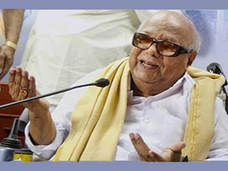
By Saeed Naqvi
The way Karunanidhi burst upon the political scene in 1953 required political imagination. He pulled together several ideas that were dear to him and which moved the people to their core. The slogans were: my land is sacred to me and no one will appropriate it; my language will not be supplanted by another;
The way Karunanidhi burst upon the political scene in 1953 required political imagination. He pulled together several ideas that were dear to him and which moved the people to their core. The slogans were: my land is sacred to me and no one will appropriate it; my language will not be supplanted by another;

capitalists from the north should be resisted if they come with hegemonic intent.
Karunanidhi put his finger on the pulse. When industrialist Ramakrishna Dalmia set up his cement factory, he sought to change the name of the town ito Dalmianagar. Students led by Karunanidhi came out in large numbers. The town reverted to its original name. Kallakudi. Brian Friel wrote Translations, a powerful play on a similar situation in Ireland in the 19th century.
This agitation set the scene for the much bigger agitation in 1965 against the imposition of Hindi. Two year later, the DMK came to power and soon abolished the three-language formula - Tamil and English would suffice.
It was only proper that he should have found a resting place beside his mentor ‘Anna’.
Relations between Karunanidhi and M.G. Ramachandran were strained since ‘Anna’s’ death in 1969. Karunanidhi’s much greater organizational control was being undermined by MGR’s cinematic glamour.
I never got to know either well: my inability with Tamil stood in the way. But with journalists MGR was both inaccessible and vindictive, if crossed. Meeting him, however, was both, a gastronomical treat and psychedelic show. The interior of his residence was a series of criss crossing, cavernous passages until you came to what in racing terms is called the ‘straight’, a 30-feet dimly-lit narrow hall, at the end of which, like a deity, sat MGR, with his trademark cap and dark glasses. He gestured that I sit on the sofa beside him. Suddenly a trolley materialized which heralded the beginning of elaborate hospitality, an endless procession of delicacies which served a twin purpose: they titillated the palate and discouraged conversation.
For me, raised on different aesthetics, MGR remained an enigma. And yet, by every yardstick, he had shot into the charismatic stratosphere by projecting an inexplicable persona. Jayalalitha performed the impossible: she amplified charisma.
We have seen the mess the AIADMK, the two charismatic leaders mindlessly left behind. DMK, however, has always more real in its politics. Not only was Karunanidhi more intellectually agile, he had his feet firmly on the ground. The cadres are in place. The next line of leadership (Stalin for instance) have been in the drill for quite some time. But the transition may be problematic.
The MGR-Jayalalitha charisma had obscured the Dravida movement’s earlier anti-Hindi, anti-north, anti-Brahmin edge. In the absence of Karunanidhi’s hardnosed pragmatism, the second line of leadership may fall back on more radical regionalism indeed, parochialism, to score points over each other.
Karunanidhi put his finger on the pulse. When industrialist Ramakrishna Dalmia set up his cement factory, he sought to change the name of the town ito Dalmianagar. Students led by Karunanidhi came out in large numbers. The town reverted to its original name. Kallakudi. Brian Friel wrote Translations, a powerful play on a similar situation in Ireland in the 19th century.
This agitation set the scene for the much bigger agitation in 1965 against the imposition of Hindi. Two year later, the DMK came to power and soon abolished the three-language formula - Tamil and English would suffice.
It was only proper that he should have found a resting place beside his mentor ‘Anna’.
Relations between Karunanidhi and M.G. Ramachandran were strained since ‘Anna’s’ death in 1969. Karunanidhi’s much greater organizational control was being undermined by MGR’s cinematic glamour.
I never got to know either well: my inability with Tamil stood in the way. But with journalists MGR was both inaccessible and vindictive, if crossed. Meeting him, however, was both, a gastronomical treat and psychedelic show. The interior of his residence was a series of criss crossing, cavernous passages until you came to what in racing terms is called the ‘straight’, a 30-feet dimly-lit narrow hall, at the end of which, like a deity, sat MGR, with his trademark cap and dark glasses. He gestured that I sit on the sofa beside him. Suddenly a trolley materialized which heralded the beginning of elaborate hospitality, an endless procession of delicacies which served a twin purpose: they titillated the palate and discouraged conversation.
For me, raised on different aesthetics, MGR remained an enigma. And yet, by every yardstick, he had shot into the charismatic stratosphere by projecting an inexplicable persona. Jayalalitha performed the impossible: she amplified charisma.
We have seen the mess the AIADMK, the two charismatic leaders mindlessly left behind. DMK, however, has always more real in its politics. Not only was Karunanidhi more intellectually agile, he had his feet firmly on the ground. The cadres are in place. The next line of leadership (Stalin for instance) have been in the drill for quite some time. But the transition may be problematic.
The MGR-Jayalalitha charisma had obscured the Dravida movement’s earlier anti-Hindi, anti-north, anti-Brahmin edge. In the absence of Karunanidhi’s hardnosed pragmatism, the second line of leadership may fall back on more radical regionalism indeed, parochialism, to score points over each other.

 RSS Feed
RSS Feed
